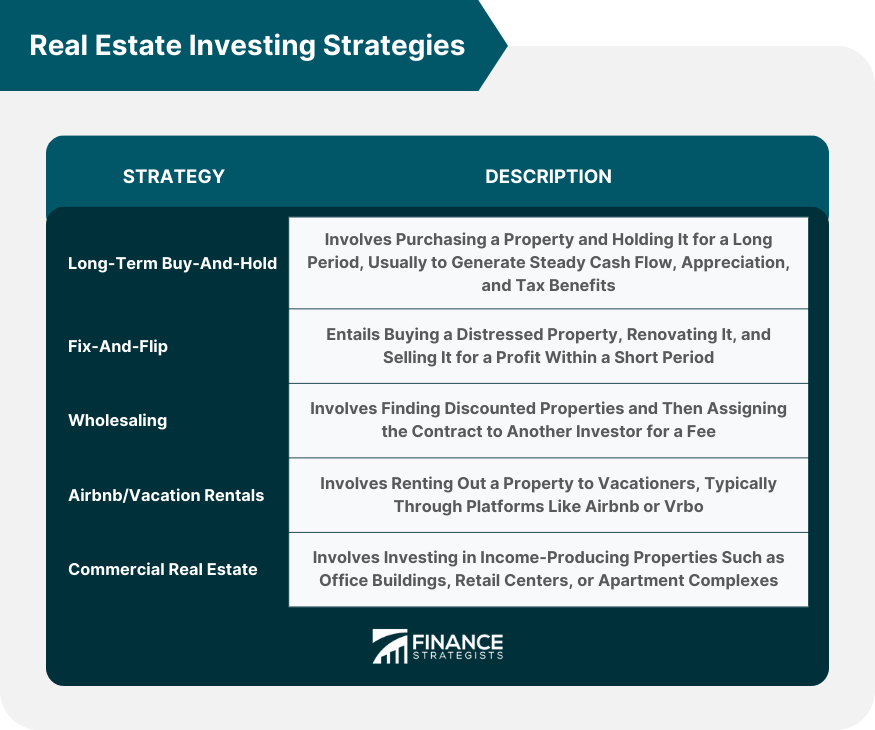Real Estate Investment Strategies

Real estate investment strategies encompass various approaches that investors can utilize to generate profits from their property investments. These strategies can range from short-term, high-risk tactics to long-term, more stable methods.
Different Types of Real Estate Investment Strategies
- Fix and Flip: This strategy involves purchasing a property below market value, renovating it, and selling it at a higher price for a profit.
- Rental Properties: Investors buy properties to rent them out to tenants, generating a steady stream of rental income.
- Real Estate Investment Trusts (REITs): Investors can invest in publicly traded REITs, which pool funds to invest in various real estate properties.
Short-term vs. Long-term Real Estate Investment Strategies
Short-term real estate investment strategies typically focus on quick returns through tactics like fix and flip or wholesaling. These strategies involve higher risks but can result in rapid profits. On the other hand, long-term investment strategies, such as rental properties or REITs, offer a more stable income stream over time and the potential for property appreciation.
The Importance of Diversified Real Estate Investment Strategy
Having a diversified real estate investment strategy is crucial for mitigating risk and maximizing returns. By spreading investments across different types of properties and strategies, investors can protect themselves from market fluctuations and unforeseen circumstances. Diversification also allows investors to take advantage of various opportunities in the real estate market.
Rental Properties
Investing in rental properties can be a lucrative venture, providing a steady stream of passive income. However, choosing the right rental property and effectively managing it are crucial for maximizing returns.
Choosing Rental Properties for Investment
- Location is key: Look for rental properties in areas with high demand and low vacancy rates.
- Consider the property condition: Ensure the property is well-maintained and does not require significant repairs or renovations.
- Evaluate the rental potential: Research the rental rates in the area to determine if the property can generate sufficient income.
- Factor in expenses: Calculate all expenses, including mortgage payments, property taxes, maintenance costs, and property management fees, to determine potential profitability.
Residential vs. Commercial Rental Properties
Investing in residential rental properties and commercial rental properties each have their own set of pros and cons.
- Residential Rental Properties:
- Pros: Easier to manage, higher demand from tenants, lower tenant turnover.
- Cons: More wear and tear, potential issues with tenants not paying rent on time.
- Commercial Rental Properties:
- Pros: Higher rental income potential, longer lease terms, tenants responsible for property maintenance.
- Cons: More complex management, higher vacancy rates, risk of economic downturn affecting businesses.
Managing Rental Properties Effectively
- Screen tenants carefully: Conduct background checks, review credit reports, and verify income to ensure reliable tenants.
- Maintain the property: Regularly inspect the property, address maintenance issues promptly, and keep the property in good condition to attract and retain tenants.
- Communicate effectively: Establish clear communication with tenants, respond promptly to their concerns, and enforce lease agreements consistently.
- Stay organized: Keep detailed records of income and expenses, create a budget for property maintenance and improvements, and stay on top of rent collection.
Flipping Properties
Flipping properties involves purchasing a property with the intention of renovating or improving it quickly and then selling it for a profit. This strategy can be lucrative if done correctly, but it also comes with its own set of risks and challenges.
Key Factors to Consider when Selecting Properties to Flip
When selecting properties to flip, it is essential to consider the following key factors:
- Location: Choose properties in desirable neighborhoods with good schools, amenities, and low crime rates.
- Market Trends: Research the local real estate market to ensure there is demand for flipped properties in the area.
- Property Condition: Look for properties that need cosmetic updates rather than major structural repairs to maximize profits.
- Budget: Calculate all costs involved in the renovation, including purchase price, renovation costs, holding costs, and selling expenses.
It is crucial to carefully analyze the potential return on investment and ensure that the property can be sold at a higher price after renovations.
Risks Involved in Property Flipping and How to Mitigate Them
Flipping properties comes with certain risks, including:
- Overestimating ARV: Avoid overestimating the After Repair Value (ARV) of the property, as this can lead to financial losses.
- Unforeseen Costs: Be prepared for unexpected renovation costs or delays that can eat into your profits.
- Market Fluctuations: A downturn in the real estate market can impact your ability to sell the property at a profit.
To mitigate these risks, conduct thorough due diligence, create a detailed renovation plan, and have a contingency fund for unexpected expenses.
Real Estate Investment Trusts (REITs)

Real Estate Investment Trusts, or REITs, are companies that own, operate, or finance income-generating real estate across a range of property sectors. Investors can buy shares in REITs, which are traded on major stock exchanges, providing a way to invest in real estate without directly owning physical properties.
Benefits of Investing in REITs
Investing in REITs offers several advantages compared to owning physical properties:
- Dividend Income: REITs are required by law to distribute at least 90% of their taxable income to shareholders in the form of dividends, providing a steady income stream.
- Diversification: Investing in REITs allows for diversification across various property types and geographic locations, reducing risk compared to owning a single property.
- Liquidity: REIT shares can be easily bought and sold on the stock exchange, providing liquidity that owning physical properties lacks.
- Professional Management: REITs are managed by experienced professionals who handle property operations, leasing, and financing, relieving investors of the day-to-day responsibilities of property ownership.
Tips for Evaluating and Choosing REITs
When considering investing in REITs, it’s essential to evaluate and choose wisely. Here are some tips to help you make informed decisions:
- Research the REIT’s Portfolio: Look into the types of properties the REIT owns, their locations, and the quality of the assets to assess the potential for income and growth.
- Check the Dividend History: Review the REIT’s dividend history to understand its consistency and sustainability in generating income for shareholders.
- Assess Management Team: Evaluate the experience and track record of the REIT’s management team in overseeing real estate investments and delivering shareholder value.
- Consider Valuation Metrics: Analyze key valuation metrics like Funds from Operations (FFO) and Price-to-FFO ratio to determine if the REIT is trading at a fair value.
Real Estate Crowdfunding
Real estate crowdfunding is a method of investing in real estate where multiple investors pool their resources together to fund a real estate project. This allows individuals to invest in real estate properties without having to buy the property outright.
How Real Estate Crowdfunding Works
Real estate crowdfunding platforms connect investors with real estate developers or property owners looking for funding. Investors can browse through different real estate projects on the platform and choose which ones to invest in. Once the project is funded, investors receive returns based on the success of the project, such as rental income or property appreciation.
Comparison with Traditional Real Estate Investments
– In traditional real estate investments, individuals typically need a large sum of money to purchase a property on their own, while real estate crowdfunding allows investors to participate in real estate with smaller amounts.
– Real estate crowdfunding provides investors with access to a diverse range of real estate projects across different locations, which may not be possible with traditional investments in single properties.
– Crowdfunding platforms often have lower barriers to entry compared to traditional real estate investments, making it more accessible to a wider range of investors.
Pros and Cons of Investing in Real Estate through Crowdfunding Platforms
- Pros:
- Lower minimum investment amounts, allowing for diversification of investment portfolio.
- Access to a wider range of real estate projects and locations.
- Potential for passive income through rental returns or property appreciation.
- Reduced management responsibilities compared to owning a property outright.
- Cons:
- Less control over the investment compared to direct ownership of a property.
- Potential for higher fees on crowdfunding platforms, affecting overall returns.
- Risk of project delays or failure, leading to potential loss of investment.
